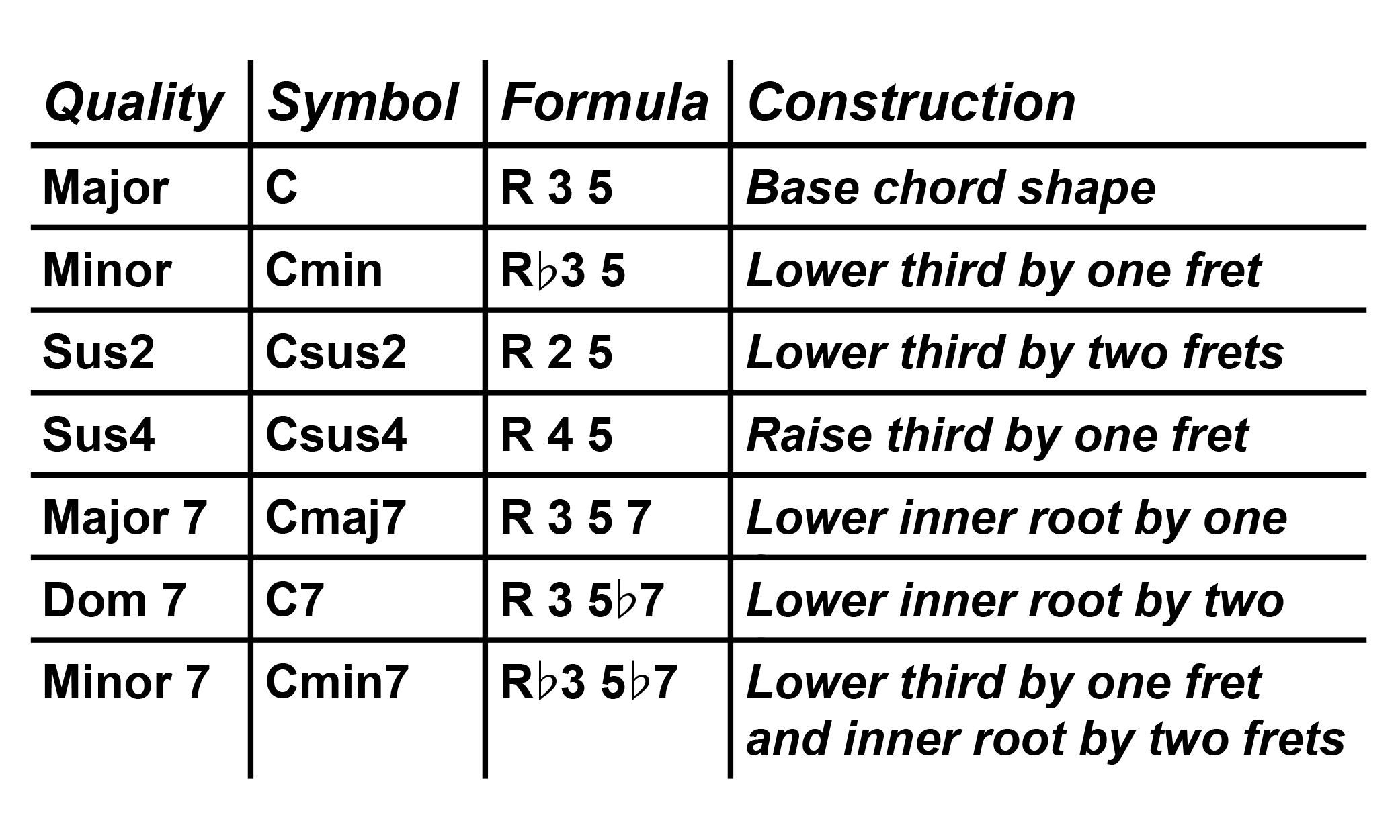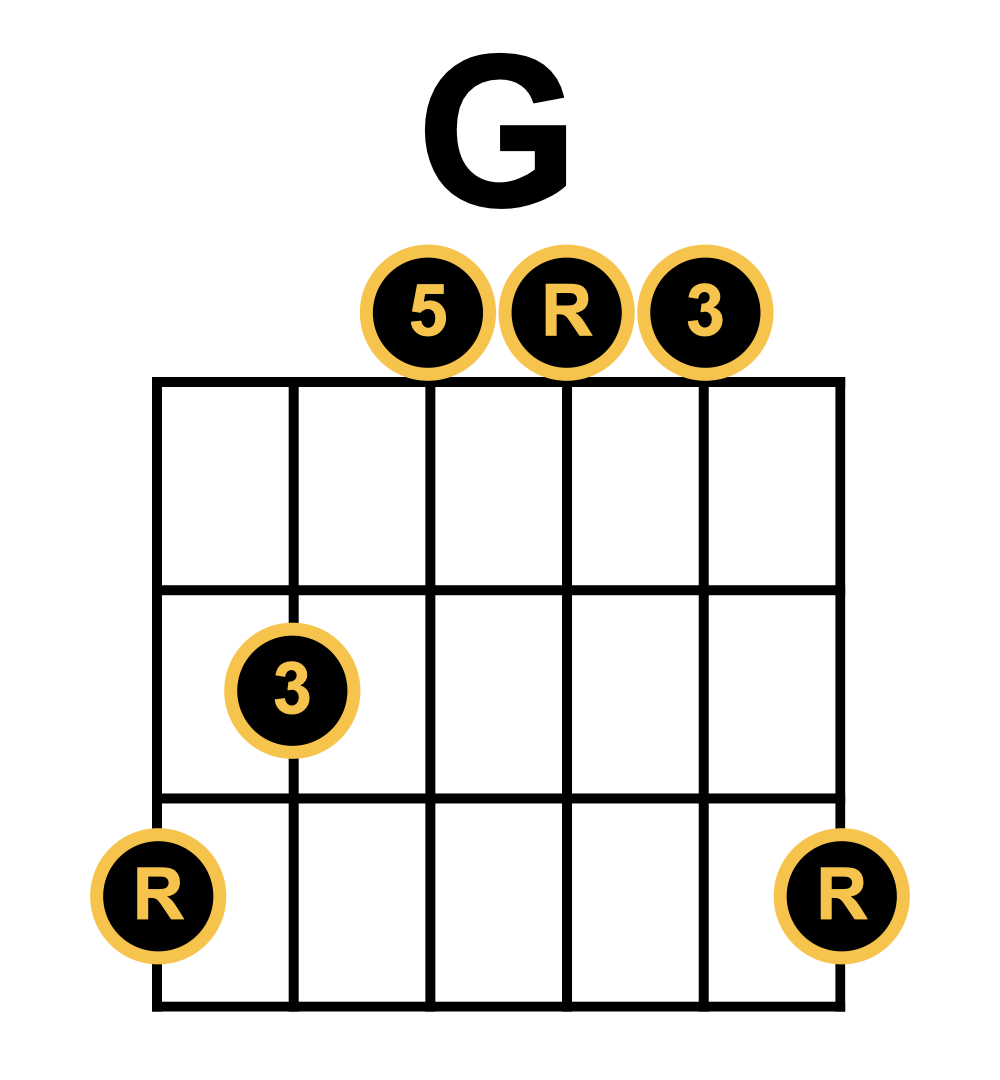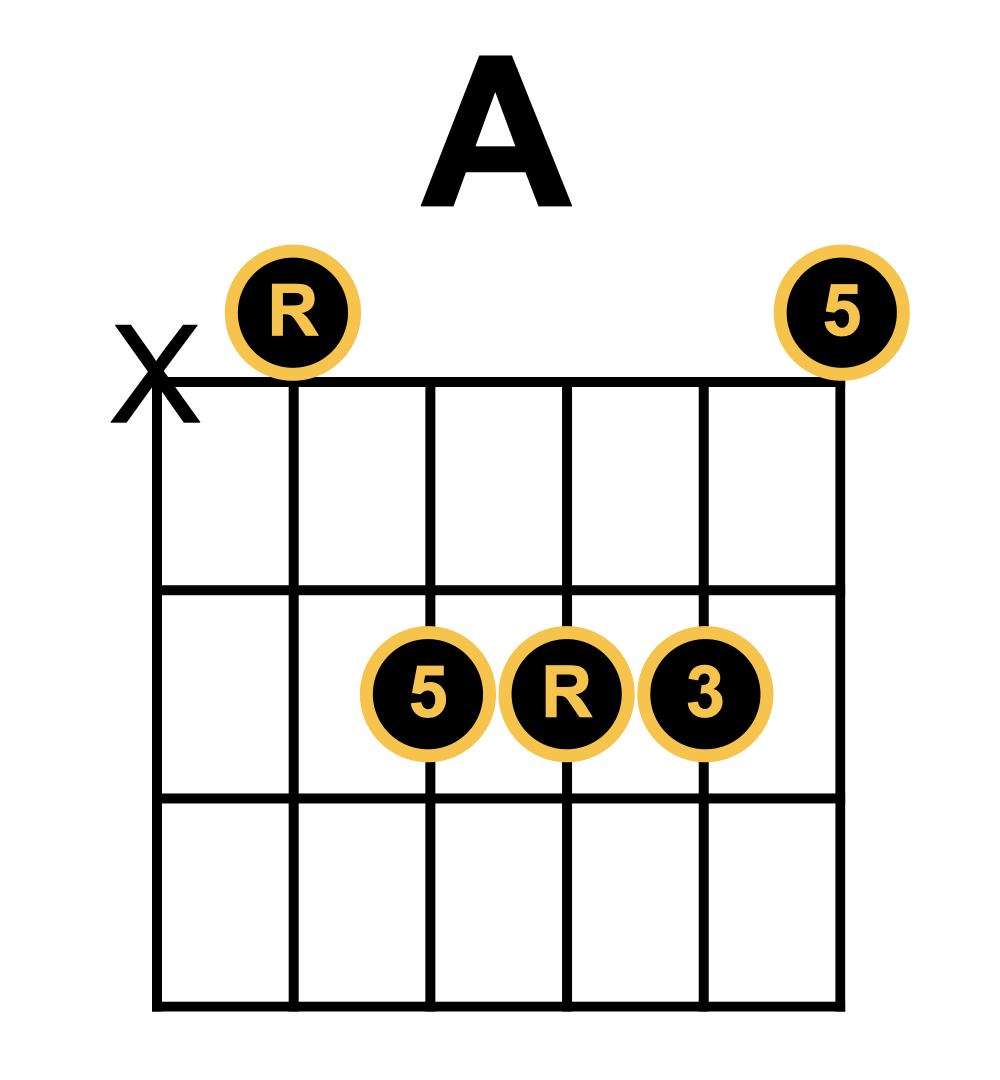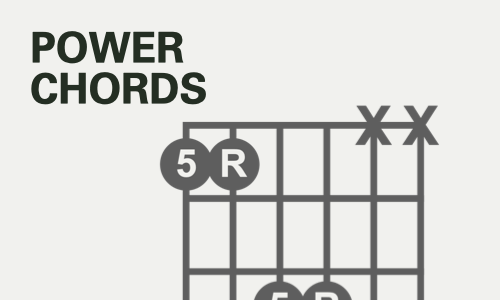Rhythm Guitar: Open Position Chords
Cowboy chords: Overview
Open position chords or Cowboy Chords are one of the most common tools that guitarists use. The shapes can be played with different picking and strumming patterns to create various textures which work for every style of music.
Learn how to create your own shapes, get a good sound, read lead sheets, and write songs using open position chords.
Dynamic Charts
How to read a dynamic chord chart
A triad is a three note chord that is made up of the Root, Third, and Fifth. The distance between these chord tones determines the chord’s sonic characteristic or quality. An easy way to think of altering chord qualities is by adjusting the chord tones of a major chord. There are five major chord shapes that use open strings. Instead of having to memorize dozens of chord shapes and charts, learn these five shapes and apply the different quality formulas to make your own shapes.
Test your ability to identify major chord shapes and create alterations by completing the Dynamic Chord Chart Worksheet
If you need extra help Watch the Dynamic Chord Worksheet Walkthrough →
Chord Qualities
There are different symbols used to show the various qualities of a chord. Unfortunately, these symbols aren’t consistent between musicians and publishers. Use this chord quality chart to decipher different chord symbols.
Notes on Extensions and Alterations
Chord tones that are above an octave are called extensions. Chord tones that are not in the basic quality that are sharped or flatted are called alterations.
C D E F G A B C D E F G A
Inner octave chord tones for C major | R=C 3=E 5=G 7=B
Extensions of C major | 9=D 11=F 13=A
If a chord symbol shows an extension or alteration, its OK to play the inner octave quality.
Example:
C13 = C7 or C | C-11 = C-7 or Cm
The Shapes
The Five Major Chords
These are the dynamic shapes for open position chords. Learn the five major shapes and apply the chord quality formulas to change the quality. They can also be viewed on This PDF →
Barre Chords
These chord shapes do not use any open string, but are based on open position chord shapes. The Bb chord is the same shape as A major and the F chord is the same shape as E major. Because these chords do not use any open strings, they can be moved to play chords with different roots. The root of the Bb chord shape is on the fifth string and the root of the F chord shape is on the E string(s).
A string barre chord shape
E string barre chord shape
Fretting Hand
Getting A Good Sound
One of the most frustrating things when playing five and six string chords is to hear buzzing and dead notes. Keep everything sounding clear by playing only the notes you need.
Keeping unwanted notes from ringing
Use the fingers of your fretting hand to keep unwanted strings from ringing.
Make your chords rign out
Use proper technique to get the best sound out of the open position shapes
Moving between chords
Use economy of motion to make switching between chords effortless.
Extended Techniques
Make the most out of open chords by adding in ornamentations and/or using a capo to transpose the pitch of the open strings.
Ornamenting A Chord
Give a chord movement by adding additional notes with open strings and other notes inside of the scale.
Using A Capo
A capo is used to transpose (move) the location of the open strings up the guitar neck. When open position chords are played with a capo, their roots are moved up by the number of frets that the capo is on.
An Emin chord played with the capo on the third fret is a Gmin chord.
Picking Hand
PICKING
The fretting hand is the brain of a chord, and the picking hand is the heart. Using pick control with accuracy can give chords emotion.
Using a Pick
The guitar is capable of great changes in volume. Controlling the pick will allow you to make chords more expressive.
Picking Hand Accuracy
Train your picking hand to play only the notes that are required for the chords you are playing.
Muting and Stopping Strings
Adding in the palm of the picking hand can create new and unique ways of starting and stopping notes.
Strumming
STRUMMING
Adding strumming to chords changes the guitar from a simple harmonic instrument into a rhythm instrument that can keep time and groove like an entire band.
Learn the basics and practice along with the strumming workout.
Strumming Basics
Use your arm and wrist like a metronome to keep everything in time.
Arpeggios
Play chords one note at a time to break up the sound.
Root Fifth Strumming
Alternate between the root of the chord and the fifth in the low voice to create a bounce in the bass.
Read
Chord and Lyrics Sheets
Chord and lyric sheets show the harmonic rhythm (when chords change) in relation to the words of a song. If you know the song, it is easy to play along. Here are some tips to finding and playing with chord and lyric sheets.
Type “(name of song) chords and lyrics” into Google to find a chart.
Listen Listen Listen to the original.
Pay attention if the song uses a Capo.
Use your ear to find the strumming pattern.
Sometimes chord and lyrics charts are wrong, use your ear and judgement when choosing a chart
Lead Sheets
Lead sheets show the harmonic rhythm of a song in relation to musical time. They are much easier to use if the player isn’t familiar with the song.
Start playing along with lead sheets by using these four measure examples.
Open this PDF if you need More Practice →
Lead Sheet Library
Apply your knowledge of chord shapes and lead sheet reading to play along with songs that you like.
Click on the album art below to open the lead sheet in a Noteflight.
Press play on the Noteflight score to hear the original audio while you play along.
Isolate sections that are difficult to play and work them out without the original audio.
Get together with another guitarist and play bass, power chords, octaves, and open position chords with the songs. Add a drummer and a singer and you have a band!
Listen
Transcription
Reading lead sheets will allow you to play songs, but learning tunes by ear will make you a great musician and guitarist. The excerpts below have been taken from famous songs that have guitar parts with open position chords. Familiarize yourself with the original recording by listening to the original version. Use the chord voicings that have been provided to find the correct progression and harmonic rhythm (the chords are not in the correct order). Listen to the strumming to find the base subdivision and copy the pattern. Try to not only copy the chords and rhythm, but copy the style as well.
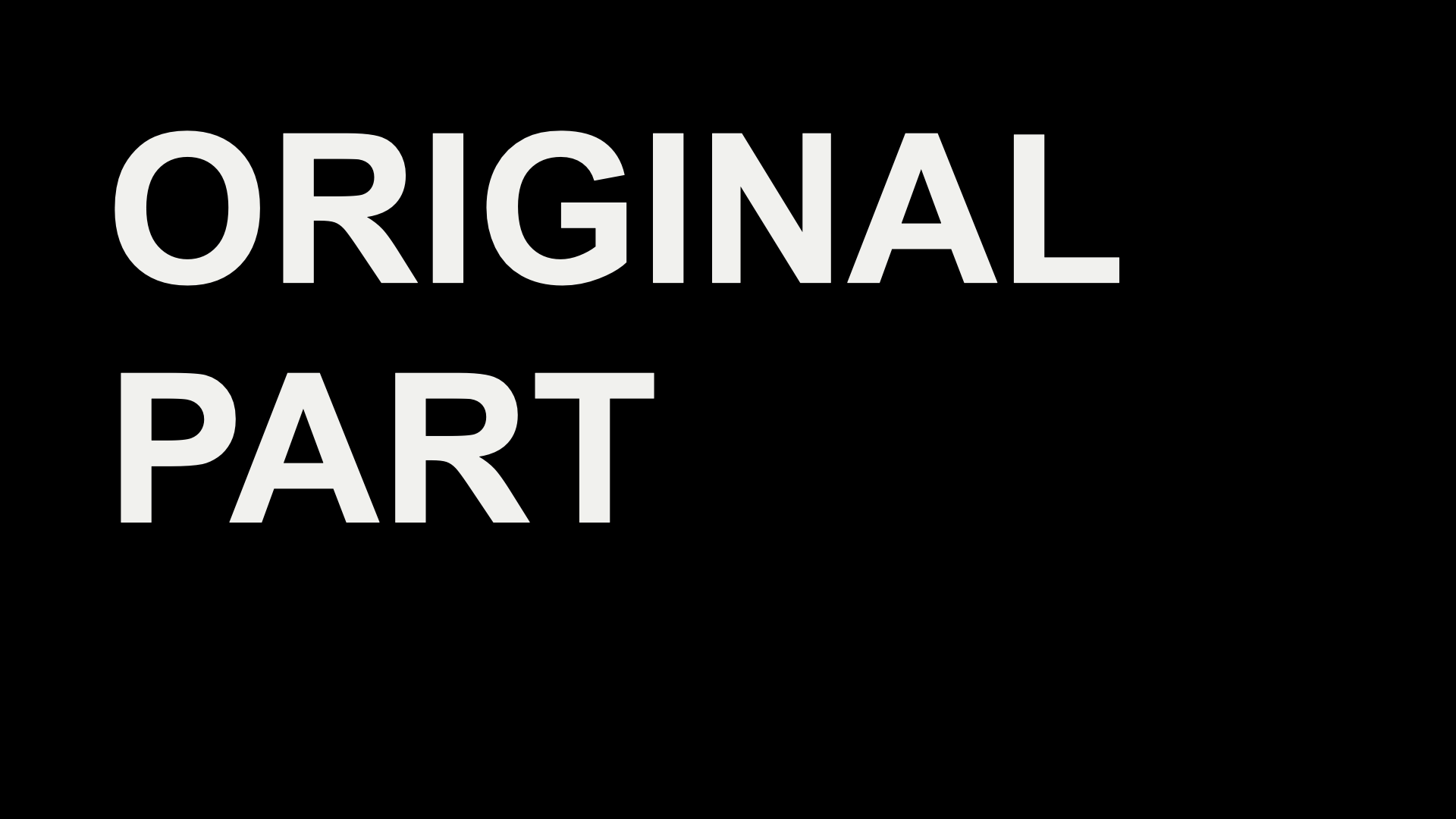
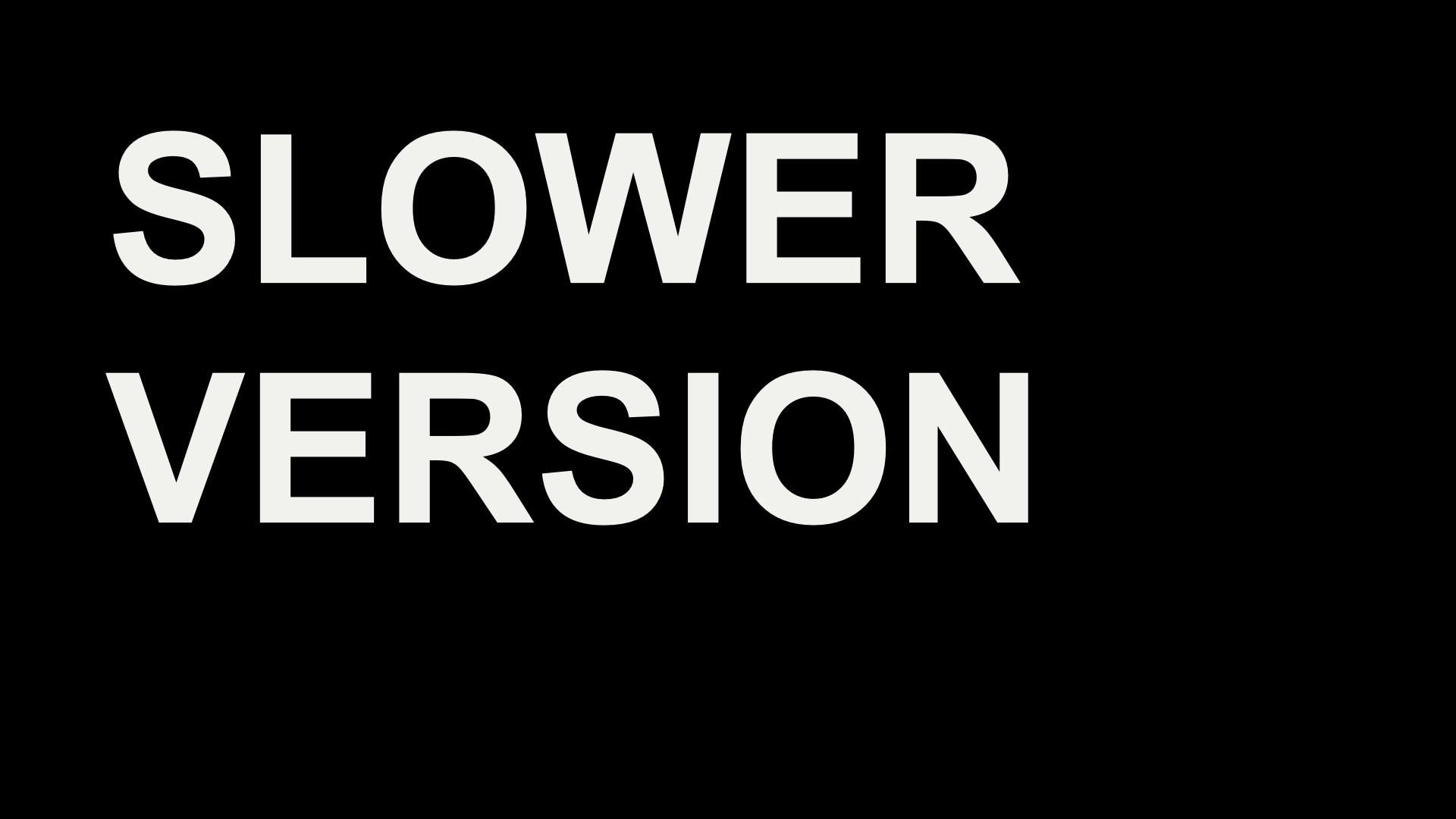
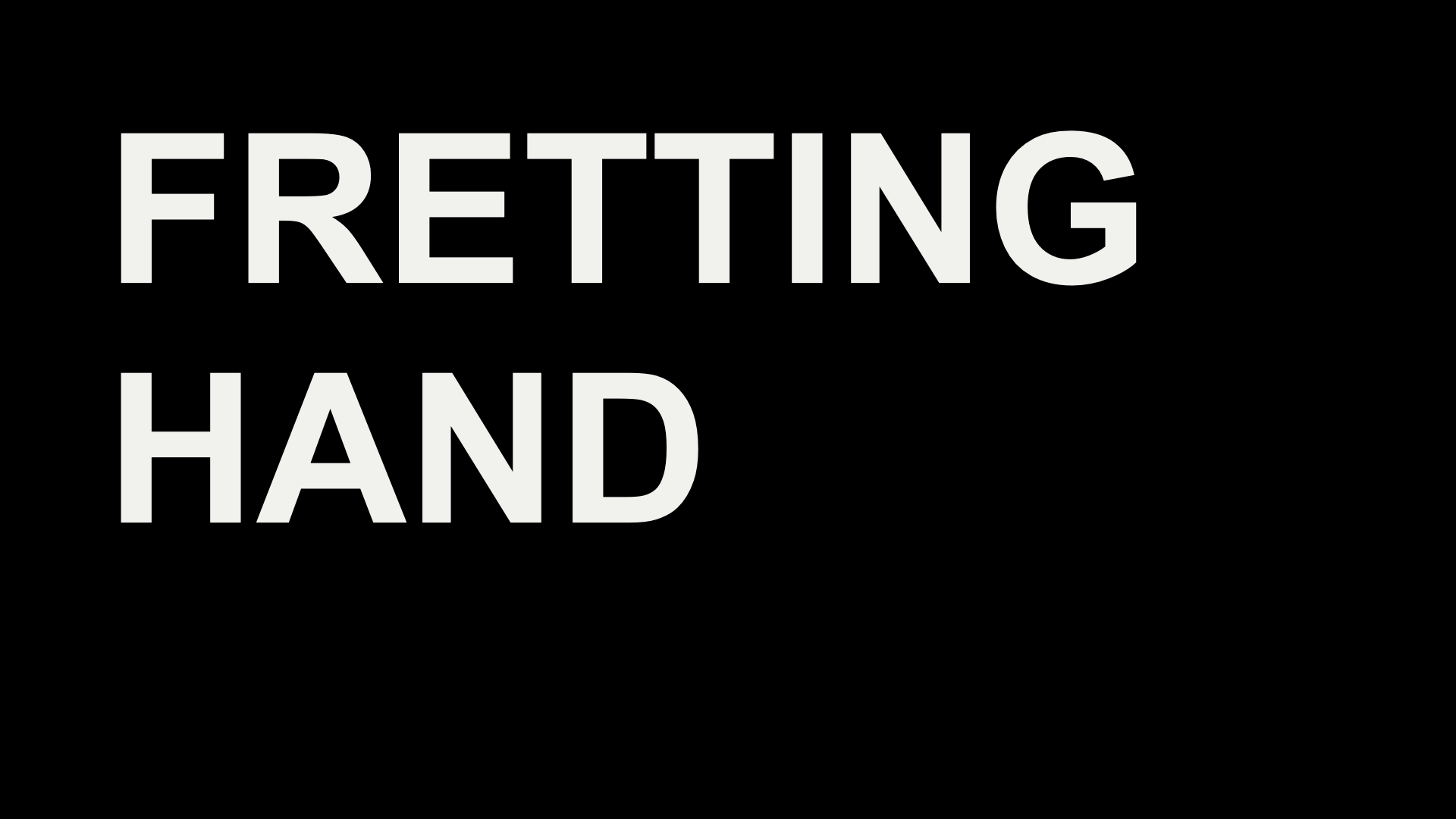





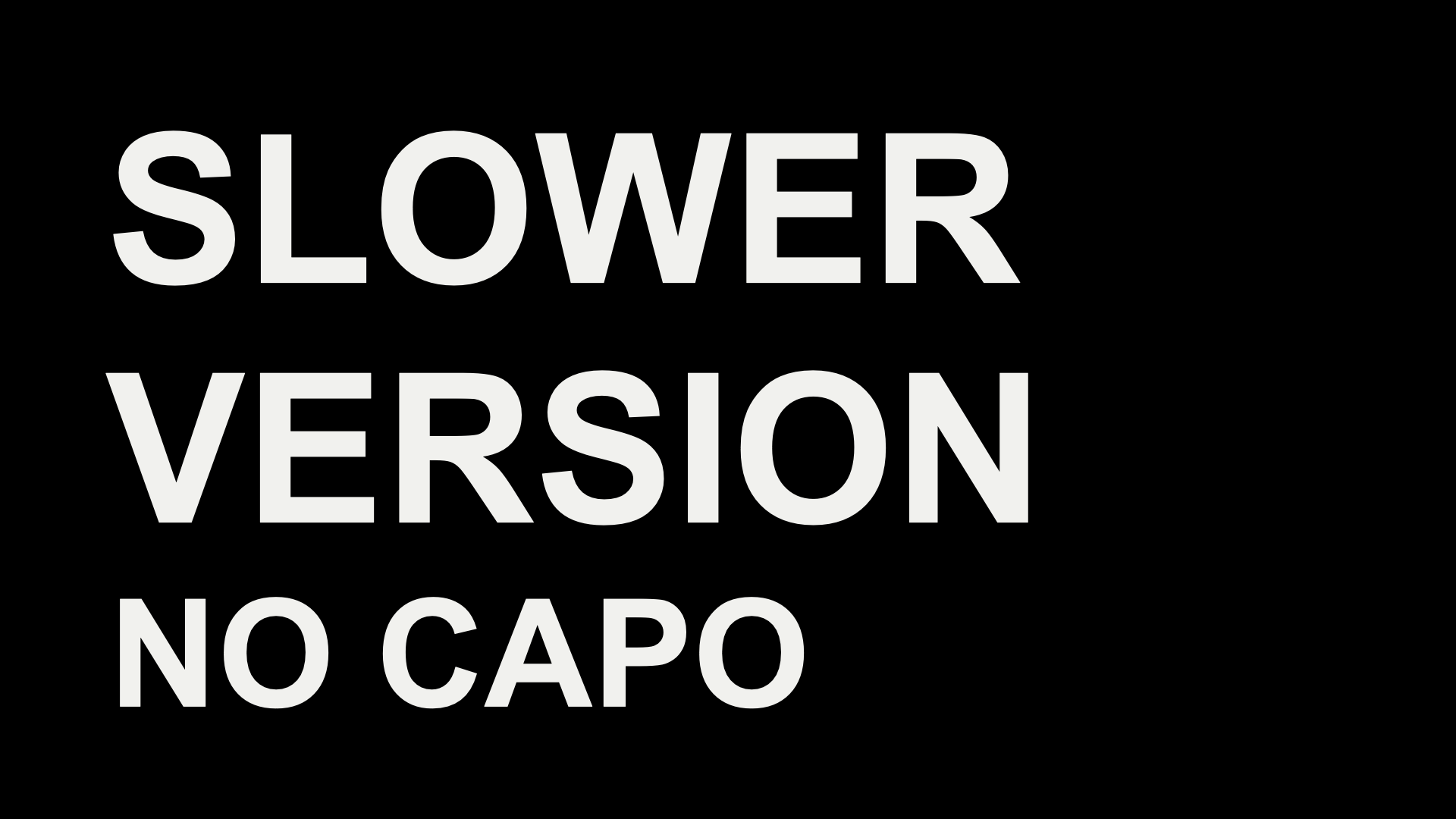





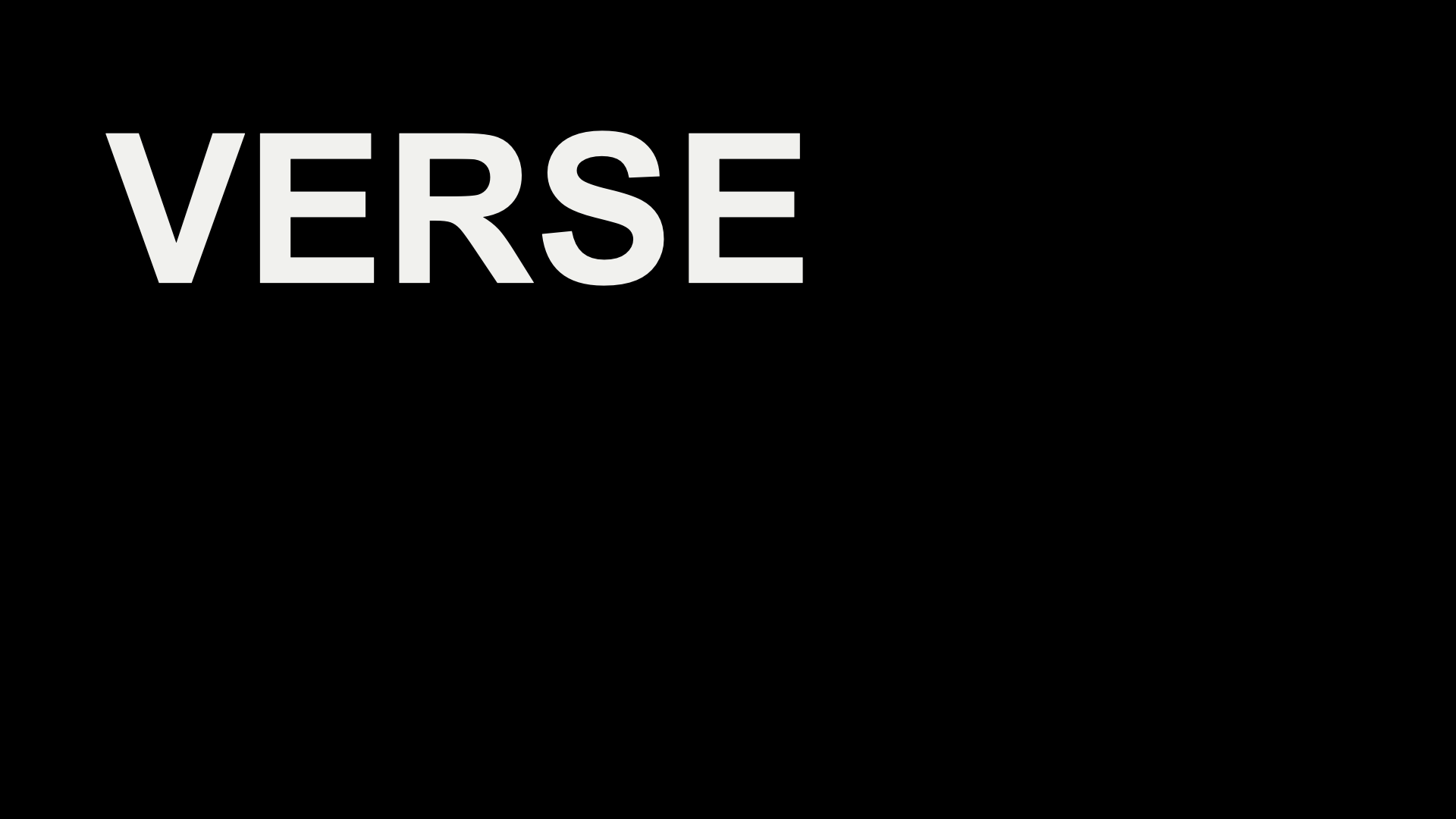
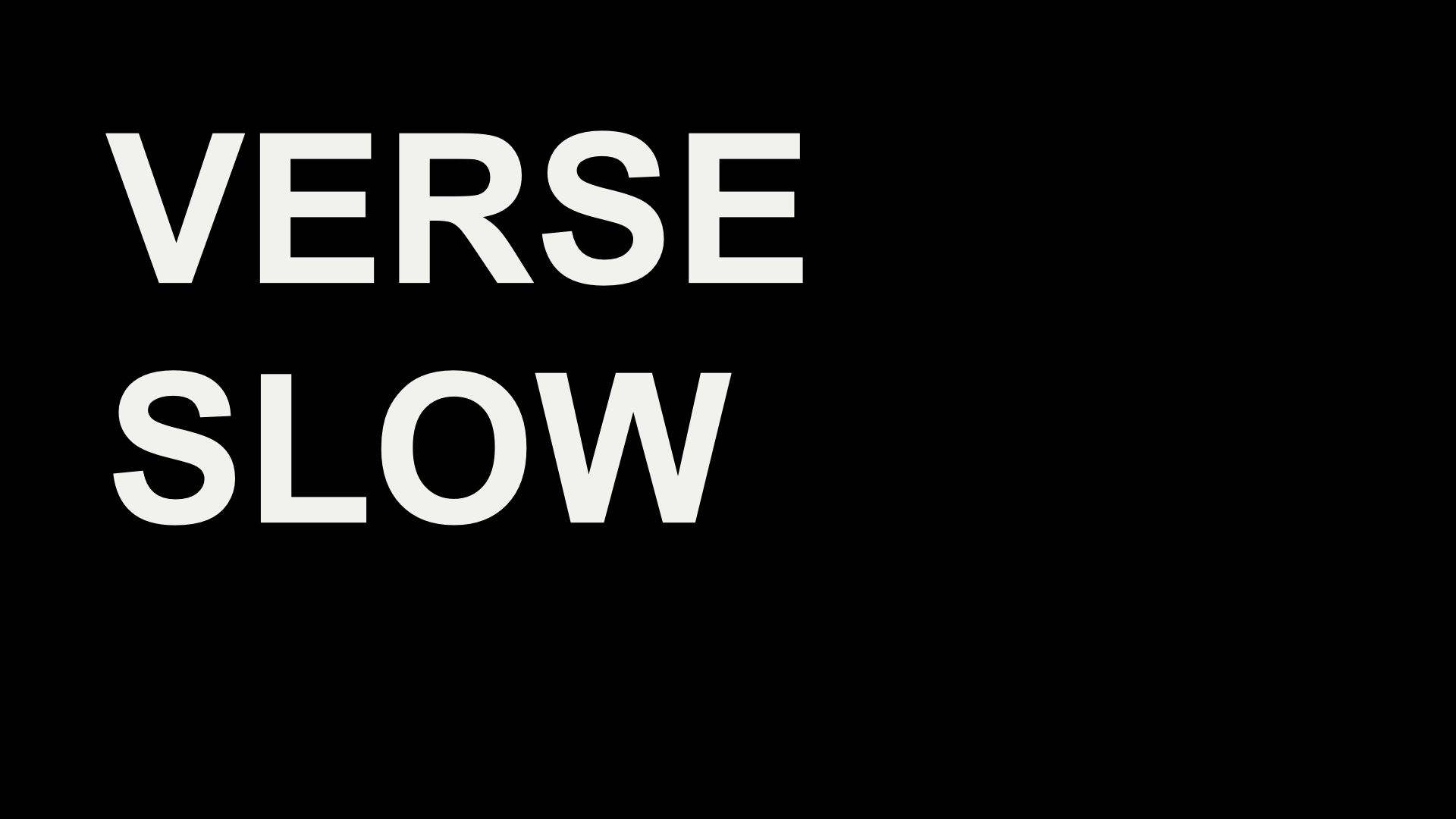









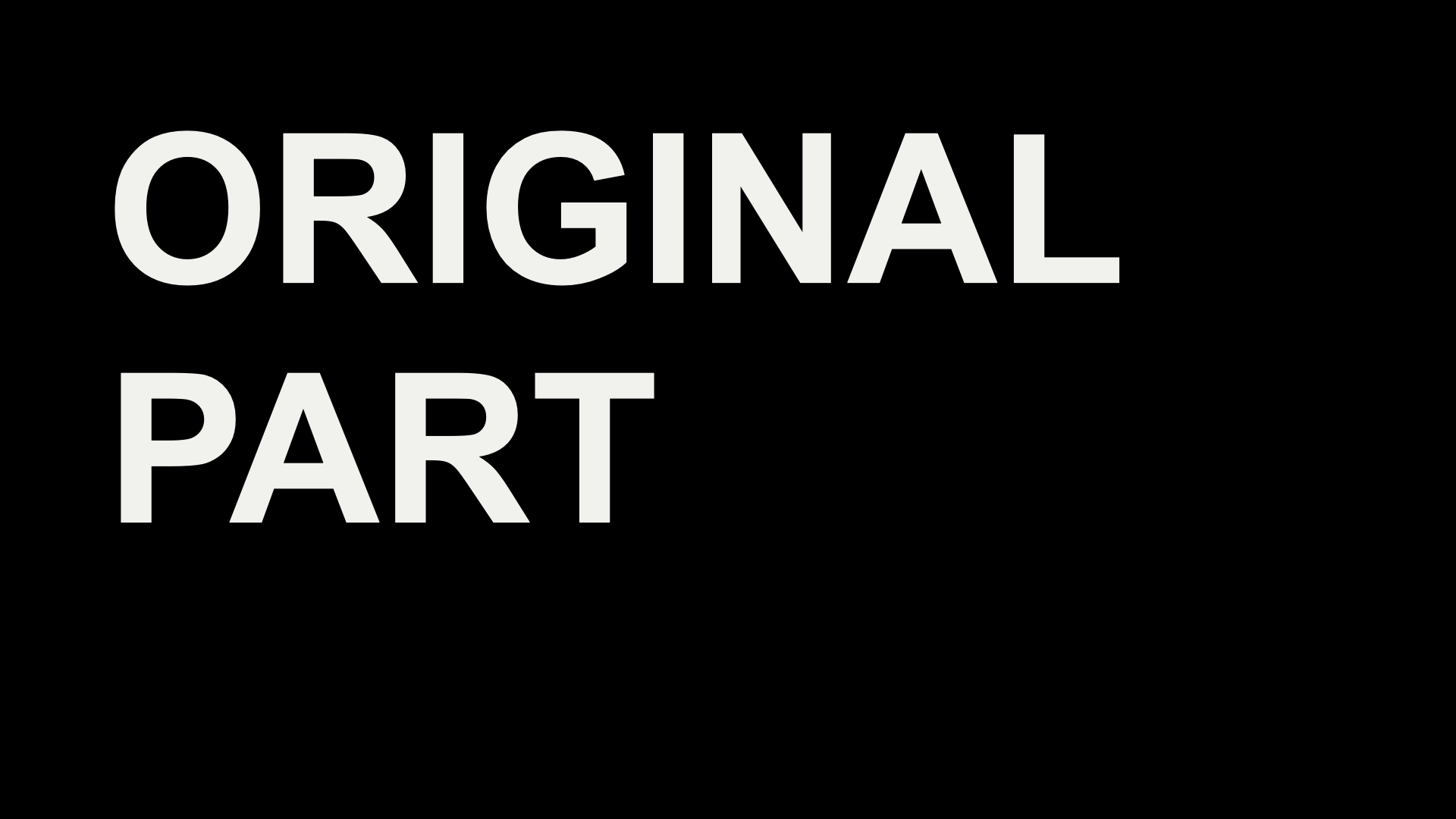
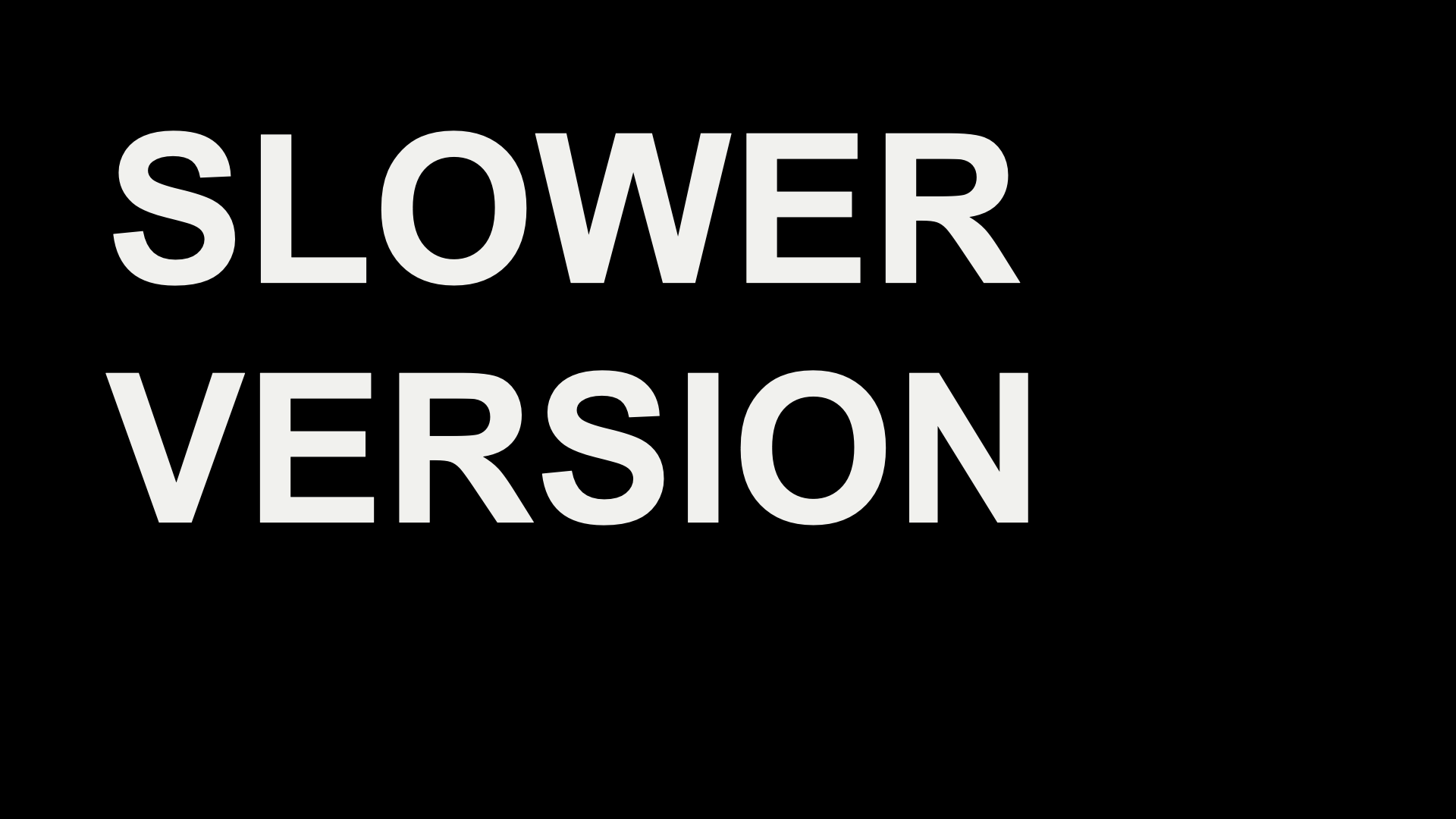
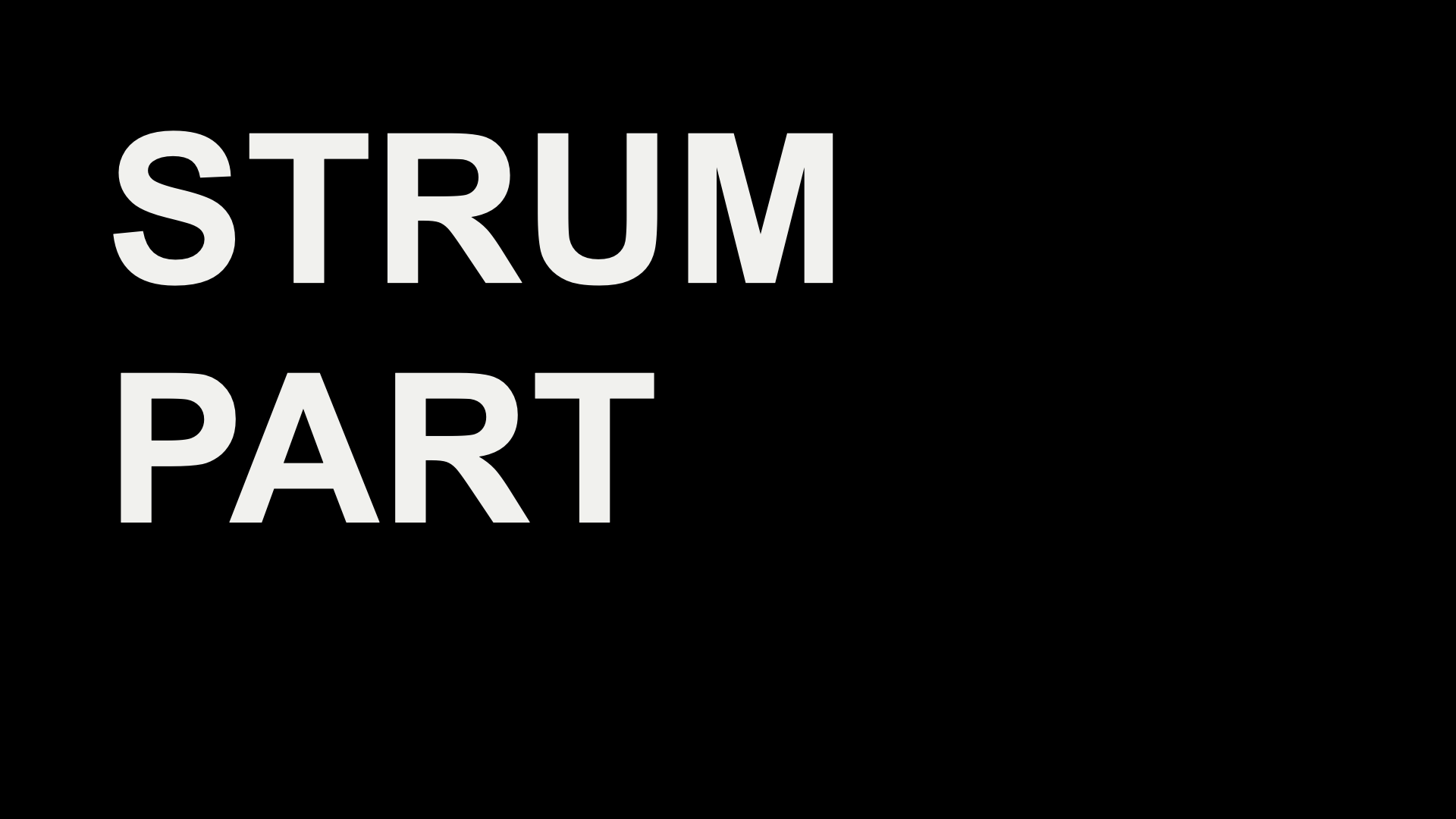
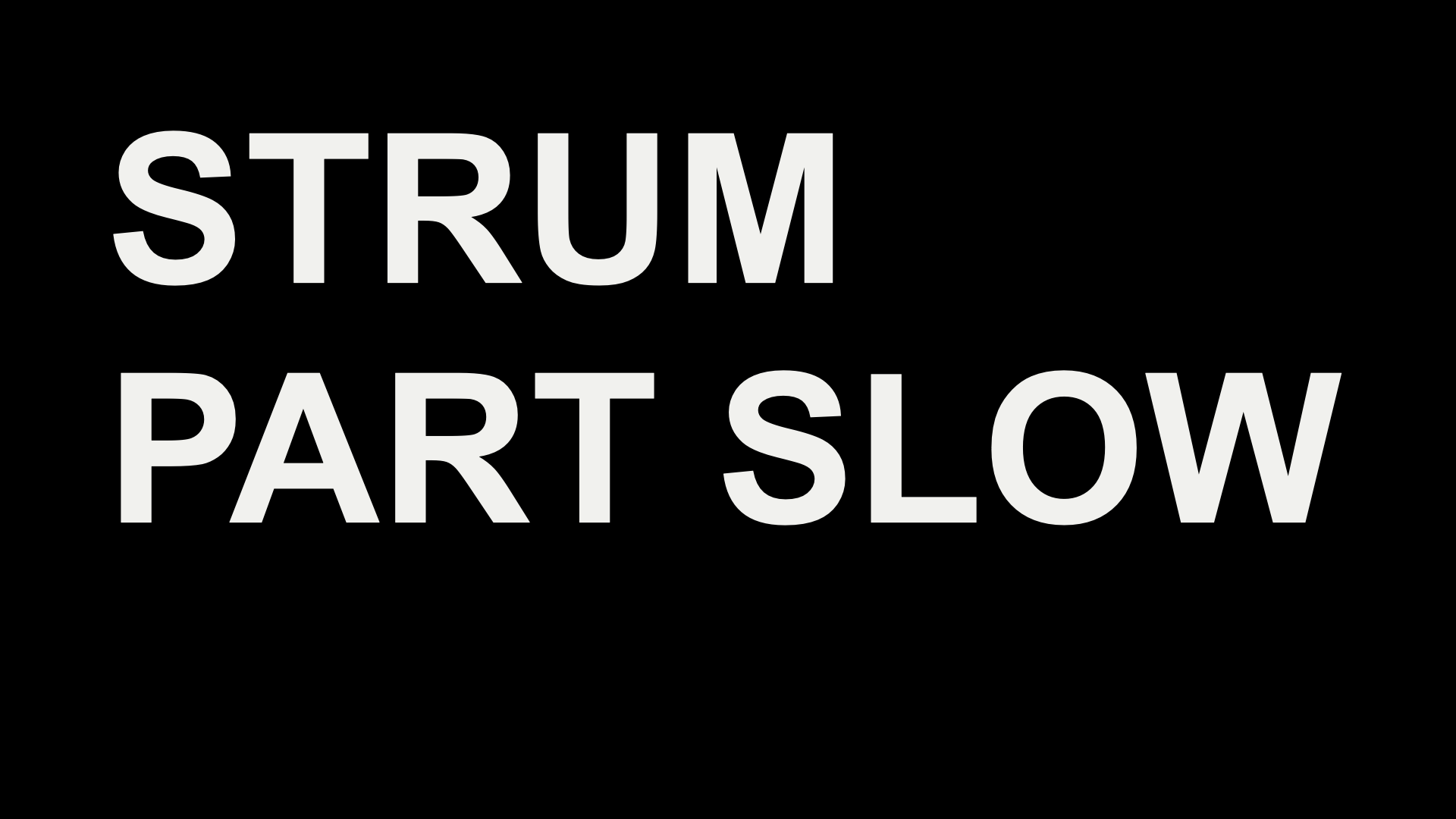
Write
Singer Songwriter Verse/Chorus Composition
One of the best ways to understand how open position chords are used is to write your own song. Listen to the playlist to get inspired by the sounds of some modern acoustic singer/songwriter music. Pay close attention to the form, lyrics, and the different ways that the guitar plays the open position chords.
Example Song
I wrote this song in ten minutes in a recording booth at the famous Ryman Auditorium in Nashville while on a trip with the music department I am part of. I’m most comfortable with starting a song by making it up on the spot. It’s easy to go back and add and tweak sections once they have been partially formed. Once you have gained comfort with the different chord shapes in one key, try it out!
Here is the chord and lyric chart for This Song →
I Find A Progression
Create three different chord progressions in the key of G that are four to eight measures in length by experimenting with different chords on the guitar.
The I is G, ii is Am, iii is Bm, IV is C, V is D, and vi is Em. You can throw an A or E in there as well.
Don’t worry about the strumming pattern or rhythms yet. Use the Chord Progression Writing page to help in the construction of your chords and the Harmonic Rhythm page to assist in knowing when the chords should change.
II Writing Lyrics
Write lyrics to match the chord progressions you wrote. There should be two or four progressions within each song section. Check to see if the rhythm of the words rhythm by saying them out loud. Rhyme words within each line and/or at the end of each line in a repeated pattern. To help with your lyrics, start or end with a phrase from this List Of Adages →
Intro- Instrumental (no words)
Verse- Tell a story, the words move faster than the chorus
Chorus- Same words, include the title of the song
Verse- Different words than the first verse
Chorus- Same as before
Bridge- New material that contrasts the verse and chorus
Chorus- Start this chorus quieter than the others
Ending- Same as the intro, repeat a section of the chorus, or stop abruptly
III Playing Variations
To change up the song sections try playing the chordal parts differently. Think about what a band does to alter repeated sections of a song and use volume, picking, strumming patterns, and rhythms to change the texture with your guitar.
IV Getting Performance/recording Ready
Once the song has been written, it has to be recorded or performed. Practice the song in sections first to solidify the playing and/or singing. Make sure you find finger placements for each chord that allows for minimal movement between chord shapes. Once each section feels comfortable, practice the transitions between the sections until you don’t have to think about the chords or lyrics any more.
MORE RESOURCES

